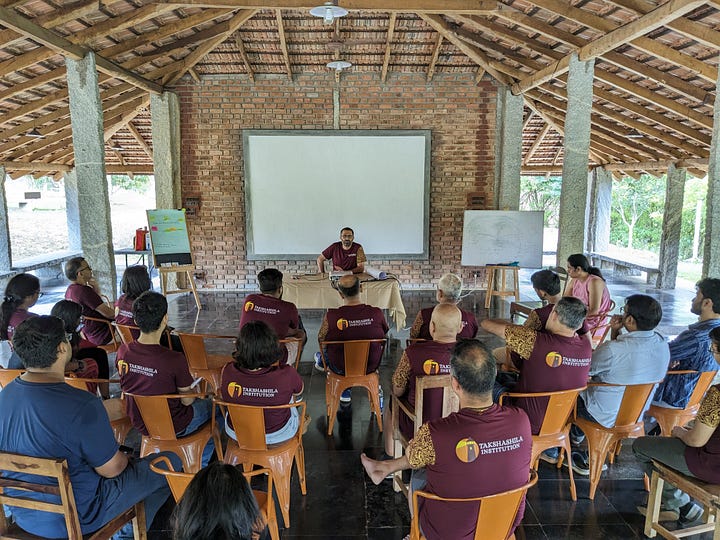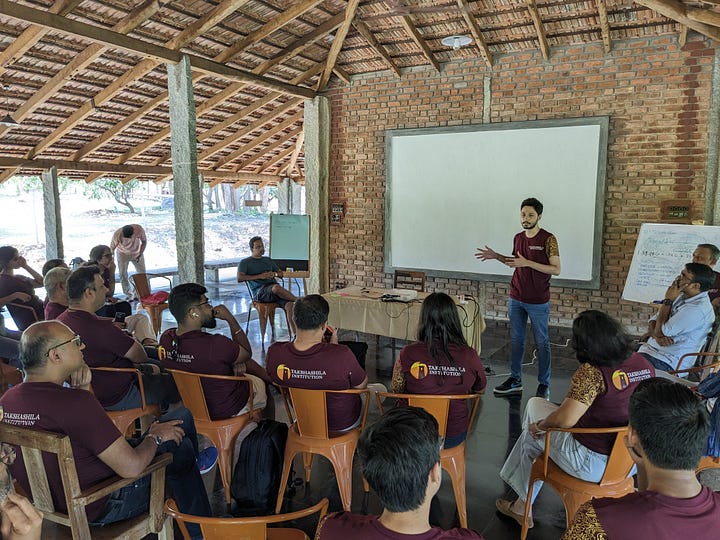Takshashila's Ideas Shala: Deepening Our Understanding of Policy
To understand and appreciate the tradition and practice of vaad and vivaad in ancient India, one has to go no further than reading Bimal Krishna Matilal’s masterly book ‘The Character of Logic in India’. Matilal was the Spalding Professor of Eastern Religions and Ethics, and Fellow of All Souls College, Oxford, and is universally acknowledged as sort of an academic bridge between Indian and Western thought.
Vaadvidya (the practice and knowledge of debating) was a much-studied and recorded subject in ancient India, and great scholars of those times produced manuals that were referred to for centuries. The most famous among those are texts from Charaka Samhita, which was originally drafted to describe the principles of Ayurveda, but have extensive detailing on debating techniques, and how they could foster thought.
The underlying belief behind these debating events was not to argue or quarrel but to produce new ideas and advance humanity’s growth.
Takshashila’s Ideas Shala is part of that rich tradition of exchange of ideas via conversation and debate, with the aim that new ideas will be generated.
On August 19 and 20, the Takshashila Ideas Shala featured an in-person gathering to learn and network at the pretty Baevu Resort (on Kanakapura Road, Bangalore) in a relaxed, spacious resort where all the 24 participants donned their policy-maker hats on.
An engaging Ideas to Action activity ensued, with director Nitin Pai driving the conversation and students working on a systems approach to find ways to put into action ideas to solve wicked public policy problems.
Our special guest Dr. Ajay Shah’s thought-provoking address to students focused on elite cohesion and economic growth. Besides Dr. Shah’s stirring speech, there were also informal discussions on policy topics.
It was not all work and no play. On Sunday morning, we took a trek up a rugged hillock and later took part in the exciting role-playing game Nagara.




But then, Takshashila has always been like this — intense discussion combined with hard play. You want to join our courses. Here’s everything you need to know!
What does the NRF mean… for you and me
Our head of research, Dr. Shambhavi Naik has a soft voice but wields a heavy-duty stick (just ask her research team!). In her op-ed in The Deccan Herald, Shambhavi held forth strongly on the much-talked-about National Research Foundation, created under the Anusandhan National Research Foundation Act.
In the simplest terms, the Indian research community is looking to the formation of the National Research Foundation (NRF) to herald a new era — where research is one of the government’s priorities resulting in access to a reasonable quantum of funding disbursed in a timely manner. But, will it?
Shambhavi points out some fundamental flaws in the structure of the NRF.
First, there is the question of unclear funding.
“If the proposed quantum of Rs 50,000 crore over five years as additional research funding is achieved, that by itself may have an impact. However, it is important that this funding is raised from new sources, and is not a simple re-labeling of existing financial flows. For example, the NRF already subsumes the SERB Act, 2008, and its associated funding, currently valued at Rs 800 crore per year. Government sources have stated that there will be no further consolidation of existing government funding for research, but the pathways for raising private or philanthropic money are unclear.”
Then, there is the big question of how much funding there actually will be?
Shambhavi writes:
“A back-of-the-envelope calculation shows that if the government raises only Rs 14,000 crore, this amounts to Rs 2,800 crore per year. Rs 800 crore would come from the allocated SERB funding. The government would then have to put in an additional Rs 2,000 crore for the NRF, which is the quantum of funding announced in this year’s budget. This would account for administrative costs and research, but the extent of the administrative capacity building required, and its costs, are not known. Thus, the actual pot of money that will be available for funding research, in the absence of significant fundraising, would be much smaller than the anticipated annual Rs 10,000 crore outlay, and might not be effective in bringing any change.”
It is literally an old wine in a new bottle, she says. Read the full op-ed here.
Those pesky laptops and their import curbs
Like Virat Kohli during his purple patch where he did no wrong and hit century upon century in all formats, Takshashila’s Anupam Manur continues his fine form to take a swipe at the government’s new laptop import policy. Anupam and Shrikrishna Upadhayaya collaborated on a podcast to do yet another deep dive into the policy that even global giants have opposed.
You can listen to the podcast here.
Our deputy director Pranay Kotasthane, too, left no stone unturned with his hard-hitting op-ed on the same policy. He asks a simple question: Why are failed policies of the 1970s and 1980s being revived again?
To quote Pranay:
“This license-tariff-raj is likely to be both counter-productive and ineffective. Counter-productive because cheap laptops are an essential input for Indian service sector businesses, including the IT sector, which is a significant export earner. A licensing regime will hurt this sector’s profitability directly. Low-income Indians and small companies benefit massively through cheaper imports. Even with exemptions, a licensing regime increases friction, incentivises corruption at customs entry, and reduces overall welfare.”
You can read his op-ed here.
Why vilify the Assam Rifles, asks Lt Gen Prakash Menon
The recent ethnic violence in Manipur has left scores dead and thousands homeless. The Assam Rifles was one of the key central paramilitary forces that were called upon to restore a semblance of peace in the troubled state.
Lt Gen Menon sees a deeper problem, though.
“While the Kuki-Zo people trust the Army/Assam Rifles personnel,” he writes in The Print, “the Meiteis deem them biased. Thus, in the context of these clashes, it appears that the Assam Rifles is being intentionally vilified, and that too under the patronage of Manipur Chief Minister N Biren Singh.”
Lt Gen Menon pulls no punches.
“The pertinent question is why the Assam Rifles is being defamed with the tacit approval of the Manipur government. The slander and the misinformation, reinforced by an FIR filed by the police against 9 AR and a memorandum from state BJP MLAs to Prime Minister Narendra Modi, cannot be disputed. The answer to the question could only be conjectured if the ultimate political purpose of the BJP government is discerned. What has politically transpired thus far is that the Kuki-Zo and Meitei communities have been physically separated, with Meiteis seeking refuge from the hilly areas dominated by the Kuki-Zo and the latter fleeing Imphal Valley to seek shelter in the hills.”
The remarkably blunt op-ed is here.
What is AI governance and why it is important to you and me
If there is one thing you can’t accuse Nitin Pai of, it is thinking ahead before others do. It is quite natural, then, that editors will sit up and listen to his advice.
Nitin asks a basic question: Why are big tech firms scaring governments and asking for regulation of AI?
In his latest column for Mint, Nitin writes:
“The manner in which the world’s big artificial intelligence (AI) companies are scaring the world’s governments and asking for regulation reminds me of how incumbent telcos used to push ‘Fear, Uncertainty and Doubt’ (FUD) 20 years ago. We should suspect that the motives are similar: to use regulation to slam the gates shut for new entrants and use incumbency to acquire greater power over public policy. If OpenAI and Google are really worried that their products are dangerous and pose severe, unpredictable risks to public safety, they could stop developing them. It is reasonable, therefore, to suspect that their calls for regulation of so-called foundation models are partly motivated by the desire to lock-in their dominant market positions.”
Well, it is time there is a nationwide debate on a topic of governance that is going to impact us all. The op-ed is here.
Let’s talk about strategic autonomy, baby!
It is no secret that strategic autonomy is at the centre of all of India’s decision-making, regardless of which party is in power. In their absolutely wonderful episode on Independence Day, Takshashila’s chair of the Indo-Pacific Programme Manoj Kewalramani was joined by colleagues Anushka Saxena, Bharat Sharma, and Amit Kumar.
What does strategic autonomy mean exactly, and why is it so fundamental to our policy-making? Listen to the episode here.
That’s all from us this week. Take care!




